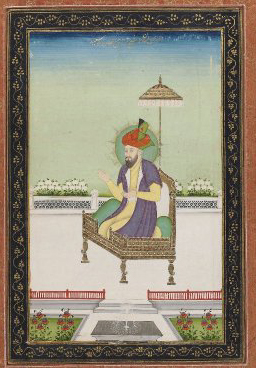Ahmad Alaq was the Khan of Eastern Moghulistan from 1487 to 1504. He was the second son of Yunus Khan. His mother was Shah Begum, fourth daughter of Badakhshan prince Lali.
Dost Muhammad Khan was Khan of Aqsu in Moghulistan from 1462 until his death. He was the son of Esen Buqa II.

Esen Buqa II was Khan of Moghulistan from 1429 until his death. He was the younger son of Uwais Khan.

Yunus Khan, was Khan of Moghulistan from 1462 until his death in 1487. He is identified by many historians with Ḥājjī `Ali, of the contemporary Chinese records. He was the maternal grandfather of Babur, founder of the Mughal Empire.
Sultan Mahmud Khan, was Khan of Tashkent and of the Moghuls of western Moghulistan (1487–1508). He was the eldest son of Yunus Khan. He was born in 1464, his mother was Shah Begum, daughter of Badakhshan prince Lali, who claimed his descent from Alexander the Great and gave one of his six daughters to Yunus Khan in marriage, pleasing his request.

Moghulistan, also called the Moghul Khanate or the Eastern Chagatai Khanate, was a Mongol breakaway khanate of the Chagatai Khanate and a historical geographic area north of the Tengri Tagh mountain range, on the border of Central Asia and East Asia. That area today includes parts of Kazakhstan, Kyrgyzstan, and northwest Xinjiang, China. The khanate nominally ruled over the area from the mid-14th century until the late 17th century.
Sultan Said Khan ruled the Yarkent Khanate from September 1514 to July 1533. He was born in the late 15th century in Moghulistan, and he was a direct descendant of the first Moghul Khan, Tughlugh Timur, who had founded the state of Moghulistan in 1348 and ruled until 1363. The Moghuls were turkicized Mongols who had converted to Islam.
Mirza Muhammad Haidar Dughlat Beg was a Chagatai Turco-Mongol military general, governor of Kashmir, and a historian. He was a Mughal Dughlat prince who wrote in both Chaghatai and Persian languages. Haidar and Babur were cousins on their mother's side, through the line of Genghis Khan. Unlike Babur, Haidar considered himself more of an ethnic Mongol of Moghulistan.
Saniz Mirza was the Dughlat amir of Yarkand from 1457/58 until his death. He was the elder of two sons of Amir Sayyid Ali.

Jahangir Mirza was a Dughlat prince and briefly the ruler of Yarkand (1514). He was the eldest son of Mirza Abu Bakr Dughlat.
Muhammad Haidar Mirza was the Dughlat amir of Kashgar from c. 1465 until 1480. He was the grandfather and namesake of the historian Muhammad Haidar Mirza (1499/1500-1551).
The Dughlat clan was a Mongol clan that served the Chagatai khans as hereditary vassal rulers of several cities in western Tarim Basin, in modern Xinjiang, from the 14th century until the 16th century. The most famous member of the clan, Mirza Muhammad Haidar, was a military adventurer, historian, and the ruler of Kashmir (1541–1551). His historical work, the Tarikh-i Rashidi, provides much of the information known about the family.

Qamar-ud-din Khan Dughlat was a Mongol ruler of Moghulistan between 1368 and 1392. He belonged to the Dughlat clan of Mongol warlords.

Umar Shaikh Mirza II was the ruler of the Fergana Valley. He was the fourth son of Abu Sa'id Mirza, the emperor of the Timurid Empire in what is now Kazakhstan, Uzbekistan, Afghanistan and eastern Iran.

The Yarkent Khanate, also known as the Yarkand Khanate and the Kashghar Khanate, was a Sunni Muslim Turkic state ruled by the Mongol descendants of Chagatai Khan. It was founded by Sultan Said Khan in 1514 as a western offshoot of Moghulistan, itself an eastern offshoot of the Chagatai Khanate. It was eventually conquered by the Dzungar Khanate in 1705.

Khanzada Begum was a Timurid princess and the eldest daughter of Umar Shaikh Mirza II, the amir of Ferghana. She was also the elder sister of Babur, the founder of the Mughal Empire. She and her brother remained deeply attached to each other all their lives, a period during which the family progressed from ruling a tiny and obscure principality in Central Asia to ruling a large portion of the Indian subcontinent. Babur conferred on his sister, the honorable title of Padshah Begum and she was really the first lady of his Empire after his death.
Shah Begum was the Queen consort of Moghulistan as the second wife of Yunus Khan, a descendant of Chaghatai Khan, the second son of Genghis Khan. She was the mother of Mahmud Khan and Ahmad Alaq, the next Moghul Khans of Moghulistan.
Sultan Mahmud Mirza was a prince of Timurid branch of Transoxiana, son of Abu Sa'id Mirza.
Daultan Sultan Khanum was a princess of the Chagatai Khanate as a daughter of Yunus Khan, the Great Khan of Moghulistan and his second wife Shah Begum. She was also the half-aunt of Emperor Babur, the founder of the Mughal Empire of India as well as its first Emperor.
Mihr Nigar Khanum was the first wife of Sultan Ahmed Mirza, the King of Samarkand and Bukhara. She was a princess of Moghulistan by birth and was the eldest daughter of Yunus Khan, the Great Khan of Moghulistan and his chief consort Aisan Daulat Begum. She was also the aunt of Emperor Babur, the founder of the Mughal Empire of India as well as its first Emperor.







